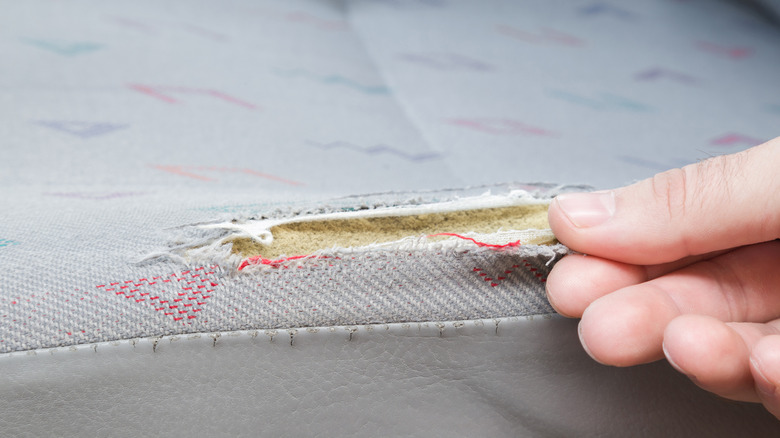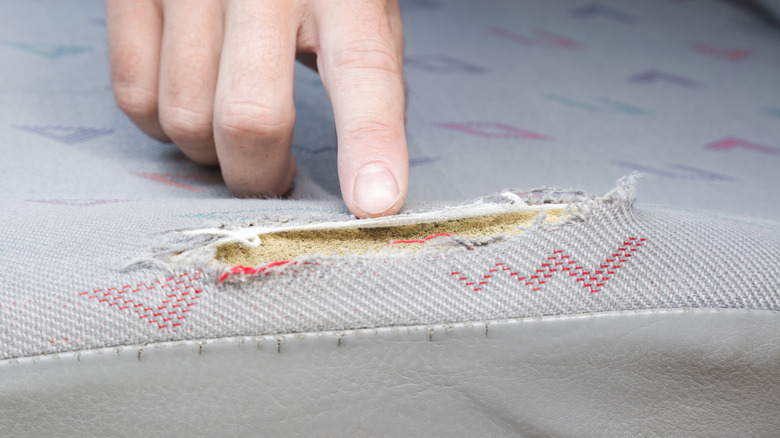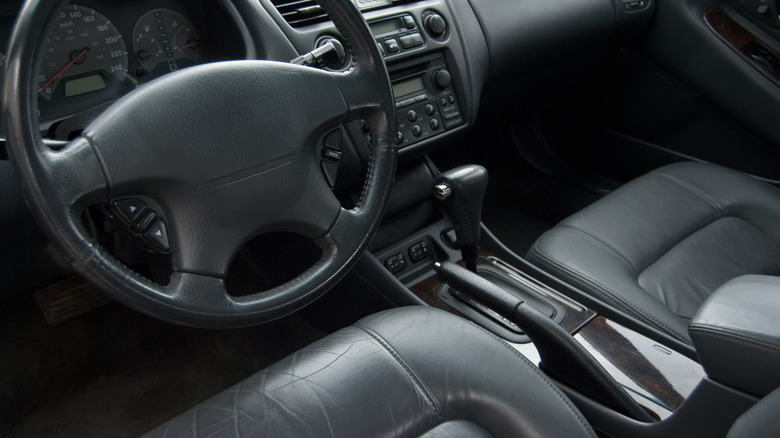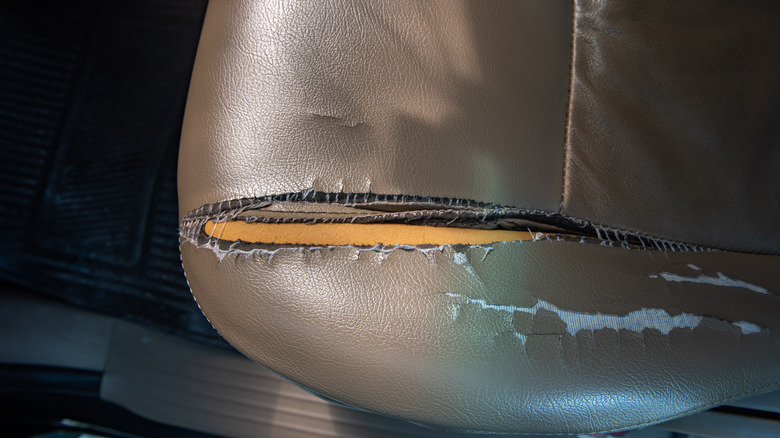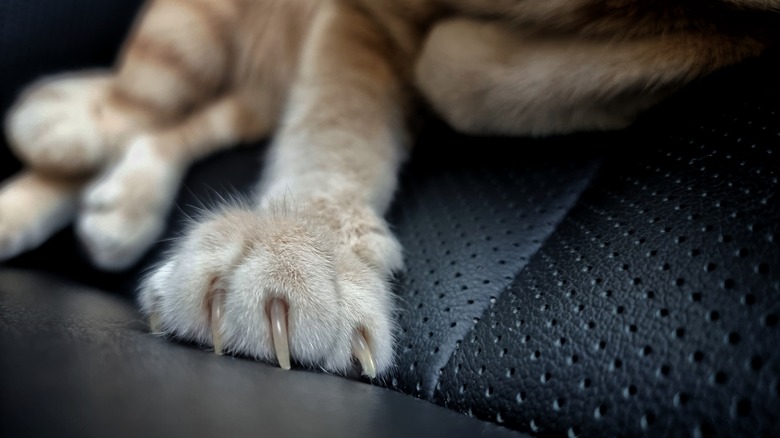Simple Ways To Repair A Tear In Your Car's Seat
We may receive a commission on purchases made from links.
Whether it's commuting to work, traveling, or something else entirely, it's safe to say that many of us spend a lot of time in our vehicles. It's also safe to say that nobody enjoys spending time sitting on uncomfortable and unseemly torn seats. Car seat repair costs range from $350 to $2,000 depending on the severity of the damage, material, make, and model of your car, so paying that much isn't too appealing, either.
Luckily, there are tools, kits, and simple ways to repair a tear in your car's seat without breaking your wallet, as long as you're willing to use a little bit of elbow grease. Unless the damage is too severe — that is, to the point where a repair is no longer possible and you have to reupholster the seats — it is possible to repair fabric, vinyl, and leather tears on your own, as well as prevent further damage to your car's interior. Keep in mind that some modern car seats will be difficult to repair at home because vehicles such as the 2020 Corvette Stingray C8 use very unique materials and colors.
How to repair a tear in your car's fabric seat
The simplicity and quality of fabric car seat tear repair will depend mostly on your sewing skills. Luckily, as long as you're willing to exercise patience, you should be able to repair most fabric car seat tears with good results. Head to a craft store and pick up a curved upholstery needle, thread, as well as liquid seam sealant. For larger holes, you'll need fabric scraps that match your car seat's color as well as material, and some type of adhesive (iron-on adhesives are recommended).
A simple tear can be fixed by stitching the torn sides together, but make sure to leave a quarter to half an inch from the edges of the tear. Once you've stitched both sides together, create a knot at the end of the thread to finish the stitch and trim off excess thread. To finish it off, use the liquid seam sealant to cover the stitched tear, thread, knot, and any needle holes that might be visible.
For a larger hole, take the fabric scrap you have and cut it so it's slightly larger than the hole. Cut out iron-on adhesive of the same size as the fabric scrap, then tuck it into the hole and put the fabric scrap on top of it. Use an iron to heat up the fabric and the adhesive, closely following the instructions provided on the iron-on adhesive. Everything should bond together and your car seat should be as good as new.
How to repair a tear in your car's vinyl seat
The most simple way to repair a tear in your car's vinyl seat is with a repair kit. You should look for a kit that matches your car seat's color and includes padding, compound, as well as a sealant. Some kits feature dyes that can be mixed at home to match your seat's color, such as this one from Amazon. To begin the process, you'll want to use some sort of cleaner and a microfiber towel to get rid of any dirt and debris. This is the most crucial part of the process, as any debris won't allow for proper bonding between the new material and the vinyl seat. Once the area is clean, you'll need to:
- Cut out the padding material so that it's slightly larger than the tear.
- Place the material inside the tear.
- Glue the material in place to serve as an anchor. Wait for it to dry.
- Use a spatula or a small knife to spread the compound over the tear over multiple coats.
- Allow each coat to dry before applying the next one.
- Sand away excess compound before painting.
After the compound dries completely, clean the area with water and a microfiber towel. Apply the paint in coats, again letting each coat of paint dry before applying the next one. Depending on the color of your seat's vinyl, you may have to apply a few extra coats of paint. Once everything dries, apply the sealant as instructed by the repair kit.
How to repair a tear in your car's leather seat
Similar to vinyl seat tears, the simplest way to fix a tear in your car's leather seat is with a repair kit. The cost of the DIY repair is about $150 to $200, assuming you purchase a quality repair kit with everything included: padding, compound, color that matches your seats, a sealant, and preferably a small spatula. Keep in mind that slightly damaged leather seats that aren't actually torn can be fixed with cream. Once you're sure that the tear can't be fixed with a cream, you'll want to clean the area around the tear in order to prepare everything for the repair process.
- Take the repair kit's padding material and cut it out so that it's slightly larger than the tear.
- Glue the padding to the inside of the seat, right behind the tear, to serve as an anchor.
- Once the glue dries, start spreading the compound in layers over the tear.
- Wait for each coat of the compound to dry before applying the next one.
- After applying the compound, sand it with soft sandpaper so that it's flush with the seat.
After the compound dries completely, you'll want to apply the paint in coats, making sure to get the shade of the color as close as possible to the color of the seat. Allow the paint to dry and apply the sealant as detailed in the instructions that came with the repair kit.
Maintaining and preventing damage to your car's seats
There are a few simple ways to maintain and prevent damage to your car's seats, as well as the overall interior. The first one would be consistently cleaning and vacuuming your car's interior, but we all know how quickly car interiors pick up dirt, so that's not as practical. Car seat covers are an affordable and effective way to prevent damage to your car's seats, and if they ever get damaged, you can replace them with new ones.
Canvas seat covers are excellent for heavy-duty activities, as well as for preventing pet scratches and hairs. However, they can be rough on the skin, so they might not be such a great option if you value comfort. Neoprene seat covers, on the other hand, are comfortable, durable, water-resistant, and resistant to scratches. There are also leather seat covers, which can even improve the comfort of your interior while at the same time protecting the original seats. You'll find many different materials used for car seat covers, with their own properties, so choose one that suits you and your needs best.
